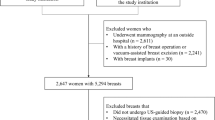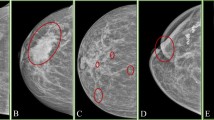Abstract
Purpose
The incidence of breast cancer increases every year. Early detection of the disease is critical since the sooner the disease is discovered the better are the treatments and the chances of cure. Mammography is now the gold standard for the diagnosis of breast cancer, but this screening tool has some limitations. Infrared thermography is being studied as a complementary tool due to its benefits. The combination of specialized professionals with methods of digital image analysis in breast thermography can contribute to improve diagnosis performance. From this, several research groups have been proposing methods to treat these data. Feature selection plays a fundamental role in this process, since it may optimize the machine learning process.
Methods
In this study, we propose a feature selection approach using genetic algorithms (GA) and particle swarm optimization (PSO) in thermographic images with breast lesions. The main goal of this approach is to optimize the identification and classification of breast lesions. We used several classifiers to assess the performance of the subsets with selected features. Support vector machines were more effective in these experiments.
Results
It was possible to reduce from 169 features with accuracy of 91.12% to 57 features with accuracy of 87.08% using the genetic algorithm. We also found a subset of 60 features with an accuracy of 86.16% using PSO.
Conclusion
The features selection step could optimize classification time and computational cost. By varying input parameters, we could achieve a significant reduction in the amount of features. Features reduction could be done without losing much in accuracy, when compared to the whole set of features.



Similar content being viewed by others
References
Andrade F, Paiva A, Correa A. Análise de imagens de termografia dinâmica para classificação de alterações na mama usando séries temporais. In SIBGRAPI 2017 - Conference on Graphics, Patterns and Images, 2017.
Azevedo W, Lima SM, Fernandes IM, Rocha AD, Cordeiro FR, da Silva-Filho G, et al. Fuzzy morphological extreme learning machines to detect and classify masses in mammogram. In: 2015 IEEE international conference on fuzzy systems (fuzz-IEEE): IEEE; 2015. p. 1–8.
Bandyopadhyay SK. Survey on segmentation methods for locating masses in a mammogram image. Int J Comput Appl. 2010;9.11(2010):25–8.
Barbosa VA, Ribeiro RR, Feitosa AR, Silva VL, Rocha AD, Freitas RC, et al. Reconstruction of electrical impedance tomography using fish school search, non-blind search, and genetic algorithm. Int J Swarm Intell Res (IJSIR). 2017;8(2):17–33.
Borchartt B, Conci A, Lima RCF, Resmini R, Sanchez A. Breast thermography from an image processing viewpoint: a survey. Signal Process. 2013;93(10):2785–803.
American Cancer Society. Cancer Facts & Figures 2019. Atlanta: American Cancer Society; 2019.
de Carvalho Filho AO, de Sampaio WB, Silva AC, de Paiva AC, Nunes RA, Gattass M. Automatic detection of solitary lung nodules using quality threshold clustering, genetic algorithm and diversity index. Artif Intell Med. 2014;60(3):165–77.
Chawla V, Bowyer KW, Hall LO, Kegelmeyer WP. Smote: synthetic minority over-sampling technique. J Artif Intell Res. 2002;16:321–57.
Commowick A, Istace M, Kain B, Laurent F, Leray M, Simon SC, et al. Objective evaluation of multiple sclerosis lesion segmentation using a data management and processing infrastructure. Sci Rep. 2018;8(1):13650.
Cordeiro FR, Lima SM, Silva-Filho AG, Santos WP. Segmentation of mammography by applying extreme learning machine in tumor detection. In International Conference on Intelligent Data Engineering and Automated Learning (pp. 92–100). Springer, Berlin, Heidelberg, 2012.
Cordeiro FR, Santos WP, Silva-Filho AG. Segmentation of mammography by applying growcut for mass detection. Stud Health Technol Inform. 2013;192:87–91.
Cordeiro FR, Santos WP, Silva-Filho AG. A semi-supervised fuzzy growcut algorithm to segment and classify regions of interest of mammographic images. Expert Syst Appl. 2016;65:116–26.
Cruz T, Cruz T, Santos W. Detection and classification of lesions in mammographies using neural networks and morphological wavelets. IEEE Lat Am Trans. 2018;16(3):926–32.
de Vasconcelos J, dos Santos W, de Lima R. Analysis of methods of classification of breast thermographic images to determine their viability in the early breast cancer detection. IEEE Lat Am Trans. 2018;16(6):1631–7.
dos Santos WP, de Assis F. Algoritmos dialéticos para inteligência computacional: Editora Universitária UFPE, Recife, Brazil; 2013.
Dourado Neto HM. Segmentação e análise automática de termogramas: um método auxiliar na detecção do câncer de mama. Master’s thesis, Federal University of Pernambuco, 2014.
Feitosa AR, Ribeiro RR, Barbosa VA, de Souza RE, dos Santos WP. Reconstruction of electrical impedance tomography images using particle swarm optimization, genetic algorithms and non-blind search. In 5th ISSNIP-IEEE Biosignals and Biorobotics Conference (2014): Biosignals and Robotics for Better and Safer Living (BRC), pages 1-6. IEEE, 2014a.
Feitosa AR, Ribeiro RR, Barbosa VA, de Souza RE, dos Santos WP. Reconstruction of electrical impedance tomography images using chaotic ring-topology particle swarm optimization and non-blind search. In 2014 IEEE International Conference on Systems, Man, and Cybernetics (SMC), pages 2618-2623. IEEE, 2014b.
Felipe J, Olioti J, Traina AJM. Discriminação de Aspectos Malignos em Massas Tumorais de Mamografias Usando Características de Forma das Imagens. V Workshop de Informática Médica (WIM 2005), Porto Alegre, RS, Brazil, 2005.
Fernandes I, dos Santos W. Classificação de mamografias utilizando extração de atributos de textura e redes neurais artificiais. In Congresso Brasileiro de Engenharia Biomédica, volume 8, 2014.
Ferreira J, Oliveira H, Martinez M. Aplicação de uma metodologia computacional inteligente no diagnóstico de lesões cancerígenas. Revista Brasileira de Inovação Tecnológica em Saúde, 2011.
Gonçalves CB. Detecção de câncer de mama utilizando imagens termográficas. Master's thesis, Federal University of Uberlândia, 2017.
Jeatrakul P, Wong KW, Fung CC. Classification of imbalanced data by combining the complementary neural network and smote algorithm. In: International Conference on Neural Information Processing: Springer; 2010. p. 152–9.
Kalfels EHH. Algoritmos genéticos como uma abordagem para a alocação de grade de horários da UFSC. Master's thesis, Federal University of Santa Catarina, 2017.
Kennedy J, Eberhart R. Particle swarm optimization. In IEEE International Conference on Neural Networks, pages 1942-1948, 1995.
Keyserlingk J, Ahlgren P, Yu E, Belliveau N. Infrared imaging of the breast: initial reappraisal using high-resolution digital technology in 100 successive cases of stage i and ii breast cancer. Breast J. 1998.
Lee H. Seleção de atributos importantes para a extração de conhecimento de bases de dados. PhD thesis, USP/São Carlos, 2005.
Leles ACQ. Desenvolvimento de procedimento e análise de imagens térmicas para a identificação do câncer de mama. Master’s thesis, Federal University of Uberlândia, 2015.
Lessa, Marengoni M. Applying artificial neural network for the classification of breast cancer using infrared thermographic images. In: Chmielewski LJ, Datta A, Kozera R, Wojciechowski K, editors. Computer Vision and Graphics. Cham: Springer International Publishing; 2016. p. 429–38. ISBN 978-3-319-46418-3.
Lima SM, Silva-Filho AG, Santos WP. Detection and classification of masses in mammographic images in a multi-kernel approach. Comput Methods Prog Biomed. 2016;134:11–29 ISSN 18727565.
Madhu H, Kakileti S, Venkataramani K, Jabbireddy S. Extraction of medically interpretable features for classification of malignancy in breast thermography. In: Annual International Conference of the IEEE Engineering in Medicine and Biology Society; 2016.
Mascaro AA, Mello CA, Santos WP, Cavalcanti GD. Mammographic images segmentation using texture descriptors. In: Annual International Conference of the IEEE Engineering in Medicine and Biology Society: IEEE; 2009, 2009. p. 3653–3.
Migowski A, Stein AT, Ferreira CBT, Ferreira DMTP, Nadanovsky P. Diretrizes para detecção precoce do câncer de mama no Brasil. I - Métodos de elaboração, vol. 34: INCA; 2015. ISBN 9788573182736. https://doi.org/10.1590/0102-311x00116317.
do Nascimento FAF, Dias AN, Figueiredo Filho A, Arce J, Miranda GDM. Use of metaheuristics particle swarm optimization in forest planning. Sci For. 2012;40(96):557–65.
Oliveira LF, Narloch ALM, Kist DM, Soares Filho MP, Meneghello GE, Cavalheiro GGH, et al. Extração de Características de Forma utilizando matriz de co-ocorrência e Atributos de Haralick. In: VIII Workshop de Visão Computacional; 2012. p. 0–5.
Pereira JMS, Santana MA, Lima NM, Sousa FN, Lima RCF, Santos WP. Método para classificação do tipo da lesão na mama presentes nas imagens termográficas utilizando classificador ELM. In: Anais do I Simpósio de Inovação em Engenharia Biomédica - SABIO 2017; 2017. p. 1–5.
Porter P. Westernizing women’s risks? Breast cancer in lower-income countries. N Engl J Med. 2008;358(3):213–6. https://doi.org/10.1056/NEJMp0708307.
Ribeiro RR, Feitosa AR, de Souza RE, dos Santos WP. Reconstruction of electrical impedance tomography images using genetic algorithms and non-blind search. In 2014 IEEE 11th International Symposium on Biomedical Imaging (ISBI), pages 153 156. IEEE, 2014.
Santana MA, Pereira JMS, Silva FL, Lima NM, Sousa FN, Arruda GMS, et al. Breast cancer diagnosis based on mammary thermography and extreme learning machines. Res Biomed Eng. 2018;34(February):45–53. https://doi.org/10.1590/2446-4740.05217.
Siciliano AV. Algoritmos genéticos e particle swarm optimization e suas aplicações problemas de guerra eletrônica. In IX Simpósio de Guerra Eletrônica, 2007.
Silva Neto OPD. Detecção automática de massas em imagens mamográficas usando particle swarm optimization (pso) e índice de diversidade funcional. Master's thesis, Federal University of Maranhão, 2016.
Simao LM. Otimização da programação da produção em refinarias de petróleo utilizando algoritmos genéticos e co-evolução cooperativa. Master's thesis, PUC- RIO, 2005.
Souza A. Seleção de atributos relevantes: aplicando técnicas na base de dados do herbário virtual da ora e dos fungos. Master’s thesis, Federal University of Amazonas, 2017.
Tavares YM, Nedjah N, Mourelle LdM. Utilização de otimização por enxame de partículas e algoritmos genéticos em rastreamento de padrões. In XII Congresso Brasileiro de Inteligência Computacional, 2015. https://doi.org/10.21528/CBIC2015-049.
Vellasco P, Lima L, Andrade S, Vellasco M, Silva L. Modelagem de Estrutura de Aço e Mistas: Elsevier; 2014.
Wang J, Xu M, Wang H, Zhang J. Classification of imbalanced data by using the smote algorithm and locally linear embedding. In 2006 8th International Conference on Signal Processing, volume 3. IEEE, 2006.
Witten I, Frank E. Data Mining Practical Machine Learning Tools and Techniques: Elsevier; 2005.
Funding
This study was funded by the Brazilian research agencies CNPq, CAPES, and FACEPE.
Author information
Authors and Affiliations
Corresponding author
Ethics declarations
All procedures performed in studies involving human participants were in accordance with the ethical standards of the institutional and/or national research committee and with the 1964 Helsinki declaration and its later amendments or comparable ethical standards.
Additional information
Publisher’s note
Springer Nature remains neutral with regard to jurisdictional claims in published maps and institutional affiliations.
Rights and permissions
About this article
Cite this article
Rodrigues, A.L., de Santana, M.A., Azevedo, W.W. et al. Identification of mammary lesions in thermographic images: feature selection study using genetic algorithms and particle swarm optimization. Res. Biomed. Eng. 35, 213–222 (2019). https://doi.org/10.1007/s42600-019-00024-z
Received:
Accepted:
Published:
Issue Date:
DOI: https://doi.org/10.1007/s42600-019-00024-z




